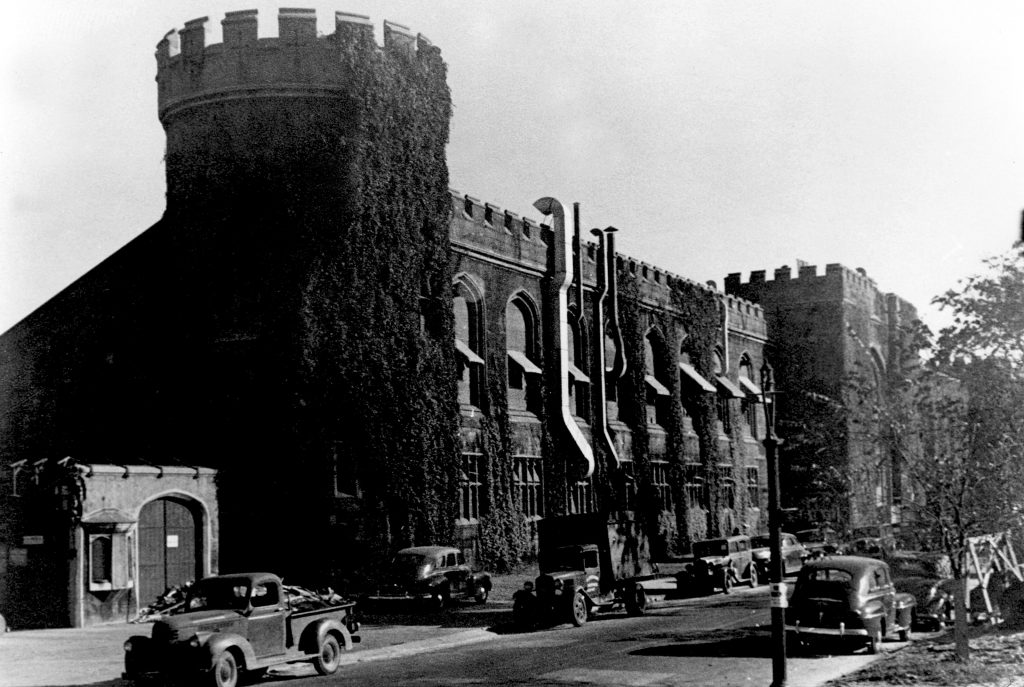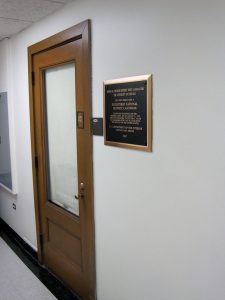Chicago, IL

One of the most important branches of the Manhattan Project was the Metallurgical Laboratory at the University of Chicago. Known simply as the “Met Lab,” the laboratory’s primary role was to design a viable method for plutonium production that could fuel a nuclear reaction. The research conducted on plutonium composition, isolation, and, later on, radiation effects, was vital to the success of the Manhattan Project.
The Chicago Pile-1 site
Starting in 1939, a team of scientists, including Enrico Fermi, Leo Szilard, Walter Zinn, and Herbert Anderson, conducted experiments at Columbia University using chain-reacting nuclear “piles” to measure the neutron emission from fission. Production was moved to the Met Lab in February 1942 with the goal of producing a self-sustaining nuclear reaction. This experimental proof could then serve as a model for large-scale plutonium production.
An abandoned rackets court underneath Stagg Field in the middle of the University of Chicago campus was chosen as the test site for the experiment. Fermi directed the project. On December 2, 1942, the Chicago Pile-1 went critical and reached a thermal output of 0.5 watts. Ultimately it operated at 200 watts maximum. Forty-nine scientists and workers witnessed the historic event. For a list of those present, click here. Fermi’s design was the basis for the B Reactor at Hanford, the first full-scale reactor, and the X-10 Graphite Reactor at Oak Ridge. For a detailed description of the Chicago Pile-1 experiment, click here.
The West Stands in Stagg Field were demolished in 1957. The University of Chicago’s Regenstein Library was later built in its place. Today, there are several plaques by the library commemorating the Chicago Pile-1. One plaque at the site reads, “On December 2, 1942 man achieved here the first self-sustaining chain reaction and thereby initiated the controlled release of nuclear energy.” There is also a large bronze sculpture, “Nuclear Energy” by Henry Moore, which marks the CP-1’s location. The sculpture was dedicated on the 25th anniversary of the CP-1 going critical in 1967.
The George Herbert Jones Laboratory
Glenn Seaborg and his team at the University of California first produced plutonium in 1941. They kept this discovery from the general public, understanding the potential for plutonium to undergo fission and be useful in an atomic bomb. Techniques for plutonium production, however, were still far from fulfilling this potential.
Seaborg, now with the resources of the Manhattan Project, continued to work on synthesizing plutonium at the Metallurgical Laboratory. In September 1942, Seaborg and his team isolated a trace quantity of plutonium in Room 405 of the George Herbert Jones Laboratory. Measuring this sample allowed them to determine plutonium’s atomic mass.
Although only Room 405 is designated as a National Historic Landmark, the building’s lobby is home to some of the tools used in the seminal isolation and measurement of plutonium. George Herbert Jones Laboratory remains home to much of the UChicago chemistry department.
Ryerson Laboratory and Eckhart Hall
Ryerson Lab and Eckhart Hall were home to many offices of Met Lab staff. Arthur Compton, Nobel Prize laureate and Professor of Physics at the University of Chicago, was the head of the laboratory. Compton’s office was in Ryerson, as was the instrument division, where James Schoke worked to develop nuclear radiation detection and measurement instruments. Both of these buildings were buzzing with activity late into the night. Szilard later wrote, “The morale of the scientists could almost be plotted in a graph by counting the number of lights burning after dinner in the offices at Eckhart Hall.”
Today, Ryerson Laboratory is home to UChicago’s Computer Science Department. Eckhart Hall houses the Department of Mathematics.
Site B
As the Met Lab grew in size, so did its needs for adequate research space. In the spring of 1943, the University of Chicago offered the Met Lab use of 6111 South University Avenue, originally built as an ice house and also used at one point as the stables. At the time, it was being used as a brewery, and the building was thus named “Site B.” It was remodeled as a laboratory by June, providing the scientists with 62,670 square feet of space.
Site B was used by scientists in the metallurgy and health divisions. Austin Brues, the director of the biology division, remembered, “The front part was occupied by Metallurgy proper and contained massive equipment which rolled, pounded, and thundered away while a bevy of young ladies in a room directly above attempted to see – let alone count – blood cells under the microscope.” The metallurgy researchers worked on developing the canning process for the irradiated uranium “slugs” that would be used in the reactors at Hanford.
The health division primarily researched the effects of radiation. As Brues also recalled, “We had an animal farm with a remarkable number of small animals, mostly mice… When enough plutonium had been manufactured so that there was enough to spare to measure in dogs and goats, one of the younger dogs slipped out of Site B past the guard who was posted to control the movements of people and packages. The runaway was pursued over several blocks of Woodlawn by an assortment of people in white coats and finally was cornered and returned to his cage.”
In recent years, controversy has emerged over the safety conditions at Site B, with allegations that at least 10 workers developed beryllium disease from their time there. Larry Kelman, a young researcher in the metallurgy division, recalled the unsafe conditions of Site B, asserting “Anybody that got into [Site B] was exposed: salespeople, the guard at the door, janitors.” An Argonne laboratory doctor would also observe “rather distressingly poor housekeeping conditions” at Site B. The building would eventually be torn down in the 1970s.
Argonne
Compton originally planned to continue the construction of experimental piles and a chemical separation plant on the University of Chicago campus. The S-1 Executive Committee decided that it would be safer to put Fermi’s pile at the Red Gate Woods, codenamed Argonne, and to build the semi-works (pilot plant) and separation facilities at Oak Ridge.
Argonne was the direct successor of the Metallurgical Laboratory. Physicists there constructed Chicago Pile-2 and Pile-3. After the war, a larger, permanent site was built in DuPage County and the original Argonne Forest site was demolished. The new site, named the Argonne National Laboratory, was the first science and engineering national laboratory in the United States.
Argonne became famous for its innovations in nuclear energy, but most early US nuclear research was devoted to weapon development. In the early years of the Cold War, policymakers focused on out-gunning the USSR. Billions of dollars went into thermonuclear weapons, and electricity-generating nuclear reactors were an afterthought. This changed in December 1953 with President Eisenhower’s “Atoms for Peace” speech. In front of the United Nations, Eisenhower acknowledged the possibility of nuclear war while emphasizing the potential of nuclear energy.
Argonne was responsible for countless nuclear “firsts,” as it was a pioneer in all fields of reactor engineering. In December 1951, Argonne’s Experimental Breeder Reactor I (EBR-I) generated usable quantities of electrity. This reactor could “breed” plutonium, that is, produce more fuel than it consumed. Argonne went on to develop the ultrasound, co-discover einsteinium and fermium, and work on the U.S.S. Nautilus, the first nuclear-powered submarine.
Today, the Laboratory is managed by the United States Department of Energy and continues to conduct nuclear science research, with a focus on reactor engineering.
Enrico Fermi and Arthur Compton Houses
During their time with the Met Lab, Enrico Fermi and Arthur Compton lived in nearby Hyde Park. Fermi lived there only for a few years in the early 1940s. The Fermi house has had several owners since, and was renovated in 2008. Arthur Compton lived in Hyde Park from the 1920s until 1945. The building has had no significant alterations since his time there, and today is a United States National Historic Landmark.
Legacy
Although the Chicago Met Lab was vital to the technological success of the Manhattan Project, it also saw significant opposition from its scientists to the proliferation and use of nuclear weapons.
Leo Szilard, adamant that the atomic bomb would have disastrous geopolitical consequences, crafted a petition in the spring of 1945 arguing that atomic attacks on Japan “could not be justified, at least not until the terms which will be imposed after the war on Japan were made public in detail and Japan were given an opportunity to surrender.” This demand was in fact more moderate than Szilard’s original proposition, which pleaded for the use of the bomb to be avoided at all costs. At Oak Ridge, the circulated petition received 67 signatures while at the Chicago Met Lab it had 69 signatories.-300x300.png)
Szilard’s petition was not the only resistance to come from the Met Lab. Soon after the Interim Committee concluded that the atomic bomb should be used as soon as possible against Japan, a group of Met Lab scientists led by physicist James Franck founded a committee to study the question of the bomb’s use. On June 11, 1945, the committee released its findings, which were mainly written by Eugene Rabinowitch and influenced by Szilard. The Franck Report categorically stated that other countries would eventually acquire nuclear weapons, and as a result, a peaceful demonstration of the atomic bomb would make the political climate more favorable to the international control of nuclear weapons.
Following the atomic bombings of Hiroshima and Nagasaki, a group of Met Lab physicists established the Bulletin of the Atomic Scientists of Chicago, an academic journal warning against the dangers of atomic weapons. Its early work was particularly concerned with nuclear secrecy and the confrontations it could provoke. With nuclear strength a secret, citizens would remain uninformed and voiceless in the face of war.
In 1947, the Bulletin established the “doomsday clock,” a measurement of how close the world is to “midnight,” or apocalypse. It was originally conceived with the danger of nuclear war in mind, but has been periodically adjusted to reflect changes in international relations, technological advances, and climate change, among other factors. Originally set at 7 minutes to midnight, the doomsday clock currently sits at 2 minutes to midnight.




